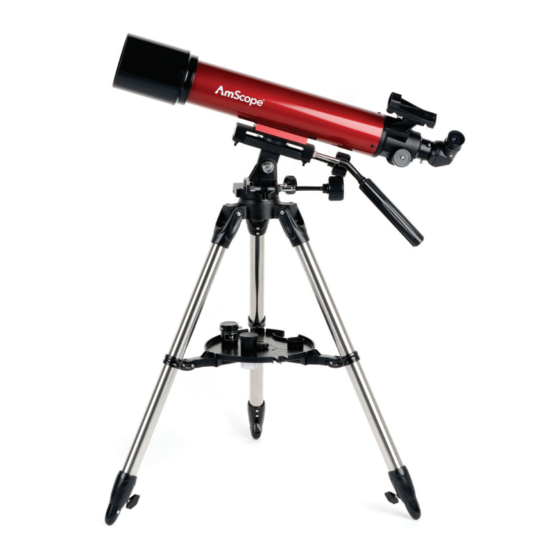AmScope TLS-60900 사용 설명서 - 페이지 11
{카테고리_이름} AmScope TLS-60900에 대한 사용 설명서을 온라인으로 검색하거나 PDF를 다운로드하세요. AmScope TLS-60900 17 페이지.

Dealing with dew
Here are a few options:
•
Dew Shield: These optical tube extensions fit over the front end of
the telescope and delay the ability for dew to form on the optics.
You can buy flexible dew shields that wrap around your telescope's
outer diameter and will lie flat when not in use or flexible heated
dew shields that will raise the dew point of the surface to keep dew
away. Choose a dew shield that is made to fit your telescope, or
measure the outside diameter of the telescope and buy according to
those dimensions.
•
Dew Strips: Dew heaters, or dew strips, are thin strips of a thick
material that have heater elements running along their length. They
wrap around the outermost edge of the telescope tube, stay put
thanks to Velcro, and plug into a hand controller, which allows you to
adjust the amount of heat applied to the surface. Dew Controllers
often are capable of handling more than one heater, so you can
have one for your telescope, one for your finder, or any other number
of accessories. Keep in mind that dew heaters and their controllers
require DC power, so when considering them, think about how they
will be powered.
•
Hairdryer: Many people use a hairdryer to blow away the dew. If you
choose this method, keep in mind that you always want to use the
LEAST amount of heat required to do the job. Overheating your
mirror will only cause distortions of your image until the glass returns
to ambient, and then the blow dryer is needed again. This is why
most people use heater strips made for the purpose. They can be set
to provide just enough heat to do the job, and only around the
perimeter of the mirror, limiting the amount of heat distortion they
cause.
Prepare your stuff in advance
Whether you are driving to a dark-sky location or are observing in your
backyard, it makes sense to make sure you collect everything you will need
19
amscope.com
for an evening under the stars before you head outside. Some people find
it works best to make a list and keep it near your telescope. Others keep
everything they need in accessory cases for quick and easy access. Whichever
organizational method you choose, keep in mind that it is better to bring
everything out at once than to keep going back into the house and subjecting
your eyes to white light, or worse yet, not have what you need when you are
miles away from home. Don't forget your red flashlight, remember to bring
extra batteries, and pack some coffee or hot cocoa while you're at it!
Red Flashlight
A red flashlight helps you see star charts and equipment in dark surroundings
with minimal impact on your night vision.
Artificial light is the enemy of amateur astronomers. When you are out
observing faint celestial objects, you need your eyes to perform at their best,
and that can only be accomplished when your pupils are as dilated as much
as possible. Our pupils dilate to allow us to see better in the dark, and any
white light that interferes with that process also interferes with our ability to
see details in the dark.
Red light is a lot friendlier to your night sight than white or yellow light, but it
still has some impact.
You need to use it judiciously and not keep it on all the time, as it can lower
your chances of observing faint deep sky objects. To minimize that impact,
turn the red flashlight on when you need to check a star chart or to adjust your
telescope or binoculars, but leave it off otherwise.
Cooling the telescope
Telescopes require at least 10 to 30 minutes of cooling down to outside
air temperature. However, this may take longer if there is a big difference
between the temperature of the telescope and the outside air. This minimizes
heat wave distortion inside the telescope tube.
Use this time for planning your session and mounting accessories.
20
amscope.com
